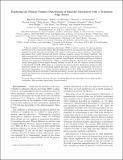Files in this item
Exploring the photon-number distribution of bimodal microlasers with a transition edge sensor
Item metadata
| dc.contributor.author | Schlottmann, Elisabeth | |
| dc.contributor.author | von Helversen, Martin | |
| dc.contributor.author | Leymann, Heinrich A. M. | |
| dc.contributor.author | Lettau, Thomas | |
| dc.contributor.author | Krüger, Felix | |
| dc.contributor.author | Schmidt, Marco | |
| dc.contributor.author | Schneider, Christian | |
| dc.contributor.author | Kamp, Martin | |
| dc.contributor.author | Höfling, Sven | |
| dc.contributor.author | Beyer, Jörn | |
| dc.contributor.author | Wiersig, Jan | |
| dc.contributor.author | Reitzenstein, Stephan | |
| dc.date.accessioned | 2018-04-27T10:30:11Z | |
| dc.date.available | 2018-04-27T10:30:11Z | |
| dc.date.issued | 2018-06-19 | |
| dc.identifier | 252944862 | |
| dc.identifier | 143fe213-adbd-4b19-aac9-365c6f00f2cc | |
| dc.identifier | 85048899583 | |
| dc.identifier | 000435552500004 | |
| dc.identifier.citation | Schlottmann , E , von Helversen , M , Leymann , H A M , Lettau , T , Krüger , F , Schmidt , M , Schneider , C , Kamp , M , Höfling , S , Beyer , J , Wiersig , J & Reitzenstein , S 2018 , ' Exploring the photon-number distribution of bimodal microlasers with a transition edge sensor ' , Physical Review Applied , vol. 9 , no. 6 , 064030 . https://doi.org/10.1103/PhysRevApplied.9.064030 | en |
| dc.identifier.issn | 2331-7019 | |
| dc.identifier.uri | https://hdl.handle.net/10023/13248 | |
| dc.description | The research leading to these results has received funding from the European Research Council under the European Union's Seventh Framework ERC Grant Agreement No. 615613, within the EURAMET joint research project MIQC2 from the European Union's Horizon 2020 Research and Innovation Programme and the EMPIR Participating States and from the German Research Foundation within the project RE2974/10-1. The authors thank the State of Bavaria for financial support. | en |
| dc.description.abstract | A photon-number resolving transition edge sensor (TES) is used to measure the photon-number distribution of two microcavity lasers. The investigated devices are bimodal microlasers with similar emission intensity and photon statistics with respect to the photon auto-correlation. Both high-β microlasers show partly thermal and partly coherent emission around the lasing threshold. For higher pump powers, the strong mode of microlaser { A } emits Poissonian distributed photons while the emission of the weak mode is thermal. In contrast, laser { B } shows a bistability resulting in overlayed thermal and Poissonian distributions. While a standard Hanbury Brown and Twiss experiment cannot distinguish between simple thermal emission of laser { A } and the temporal mode switching of the bistable laser { B }, TESs allow us to measure the photon-number distribution which provides important insight into the underlying emission processes. Indeed, our experimental data and its theoretical description by a master equation approach show that TESs are capable of revealing subtle effects like mode switching of bimodal microlasers. As such our studies clearly demonstrate the benefit and importance of investigating nanophotonic devices via photon-number resolving transition edge sensors. | |
| dc.format.extent | 2701307 | |
| dc.language.iso | eng | |
| dc.relation.ispartof | Physical Review Applied | en |
| dc.subject | Photon-number resolving detectors | en |
| dc.subject | Transition Edge Sensor | en |
| dc.subject | Microlaser | en |
| dc.subject | Cavity quantum electrodynamics | en |
| dc.subject | Photon-number distribution | en |
| dc.subject | Photo statistics | en |
| dc.subject | QC Physics | en |
| dc.subject | T Technology | en |
| dc.subject | NDAS | en |
| dc.subject.lcc | QC | en |
| dc.subject.lcc | T | en |
| dc.title | Exploring the photon-number distribution of bimodal microlasers with a transition edge sensor | en |
| dc.type | Journal article | en |
| dc.contributor.institution | University of St Andrews. School of Physics and Astronomy | en |
| dc.contributor.institution | University of St Andrews. Condensed Matter Physics | en |
| dc.identifier.doi | 10.1103/PhysRevApplied.9.064030 | |
| dc.description.status | Peer reviewed | en |
This item appears in the following Collection(s)
Items in the St Andrews Research Repository are protected by copyright, with all rights reserved, unless otherwise indicated.

